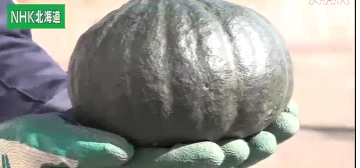In the coastal town of Tomamae, Hokkaido, the annual harvest of the renowned Kuri Aji Pumpkin is in full swing. This pumpkin, distinct for its chestnut-like shape and sweetness, has earned a reputation for being one of the tastiest varieties in Japan. The harvest period, which began in mid-August, is now reaching its peak, as farmers work tirelessly to collect this prized crop.
Unique Characteristics and Growing Conditions
What sets the Kuri Aji Pumpkin apart is its remarkable sweetness and starchy texture, often compared to that of chestnuts. This particular variety is only grown by about 30 farms in Tomamae, making it a regional specialty. The growing season in 2024 has been particularly favorable. Although the early planting season saw cooler-than-usual temperatures, the subsequent warm weather helped the pumpkins grow large and sweet.
Farmer Takuji Ueda manages a 4.7-hectare plot where he and his wife carefully harvest each pumpkin by hand. Using specialized shears, they cut the stem, ensuring each pumpkin is harvested at the ideal time for maximum sweetness. Once collected, the pumpkins undergo a meticulous process of cleaning and drying. After being polished with towels and brushes, they are stored in well-ventilated areas for about ten days. This drying period is crucial, as it enhances the natural sweetness of the pumpkins before they are shipped.
Market and Distribution
The Kuri Aji Pumpkin has become a sought-after delicacy, primarily shipped to markets in the Kanto and Tohoku regions of Japan. As the harvest continues through late September, demand for these pumpkins remains high, particularly because of their limited availability and distinctive flavor. Farmers like Ueda take great pride in this crop, which not only supports the local economy but also brings a taste of Hokkaido’s agricultural excellence to the rest of Japan.
The Future of Kuri Aji Pumpkin Farming
Farmers in Tomamae are optimistic about the future of Kuri Aji pumpkin cultivation. With the growing interest in locally sourced and specialty produce, there is potential for expansion into new markets. However, maintaining the quality and sweetness that has made the Kuri Aji pumpkin famous remains the top priority for farmers. To continue producing high-quality pumpkins, they emphasize the importance of climate management, soil health, and careful harvesting techniques.
The Kuri Aji pumpkin is more than just a crop; it is a symbol of Tomamae’s agricultural heritage. Thanks to favorable growing conditions and the dedication of local farmers, this year’s harvest is expected to be one of the best yet. As more consumers discover the unique flavor of this sweet pumpkin, its reputation will likely continue to grow, making it a key product in Japan’s agricultural landscape.






























